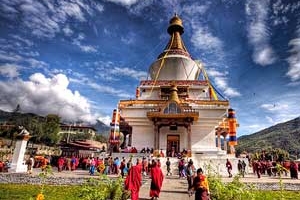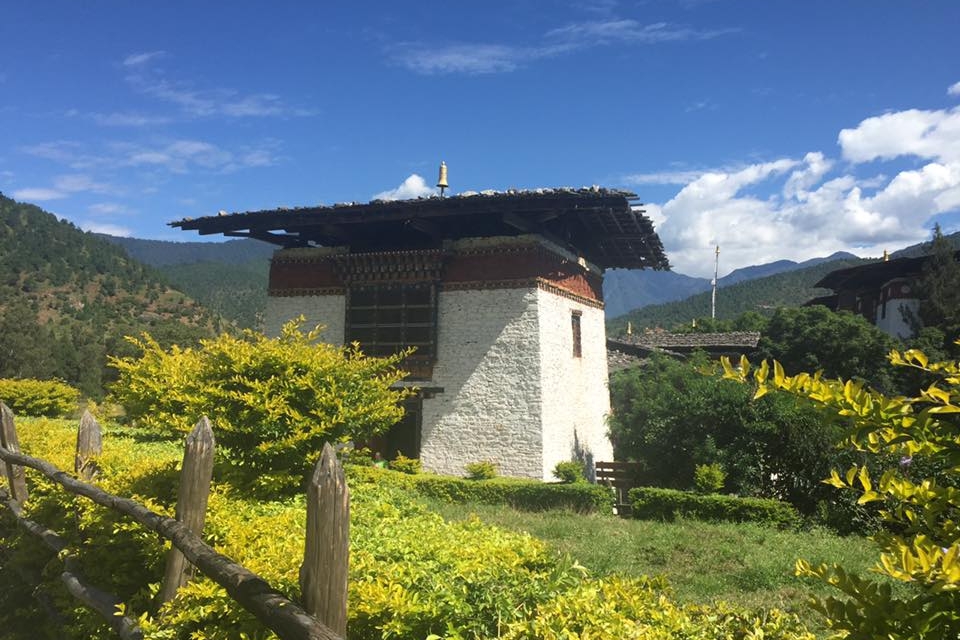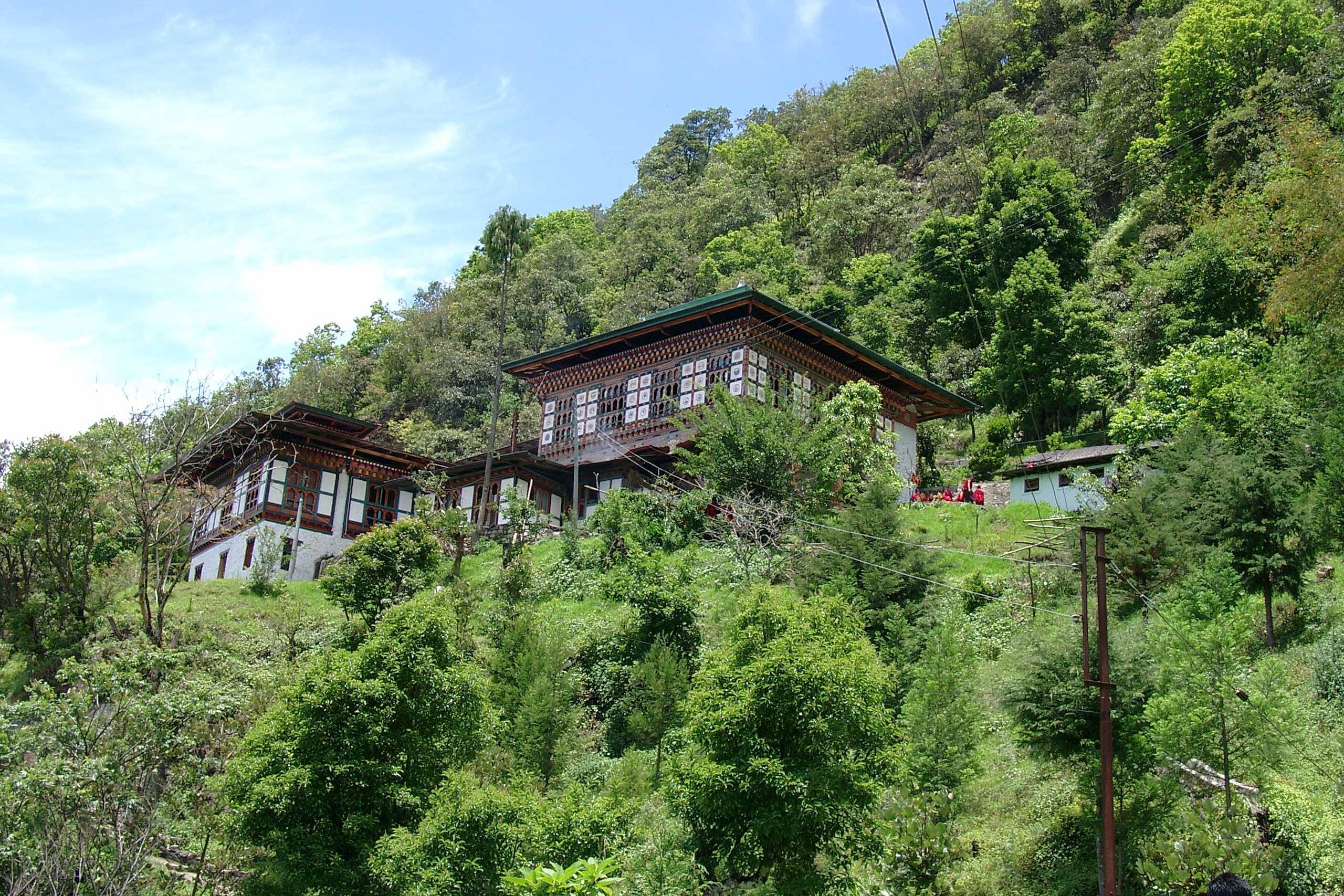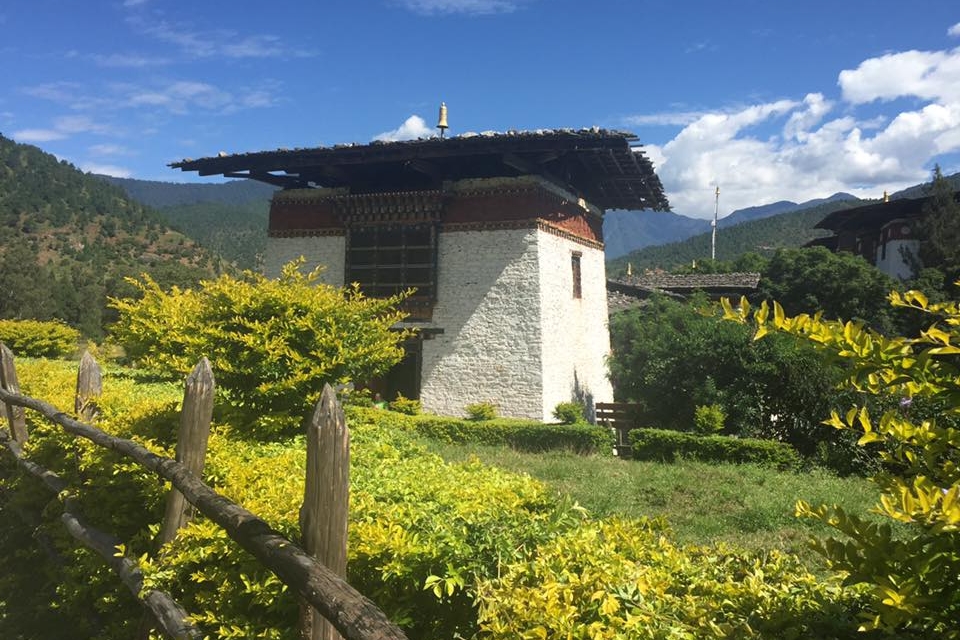Fly over to the Buddhist kingdom, Bhutan passing by Mountains of 5500 meters to Paro. Paro is a beautiful valley and is home to many of Bhutan’s oldest monasteries and temples, and the country’s only international airport. The flight to Paro is one of the most spectacular mountain flights in the world, with a constantly changing panorama of some of the highest mountains on earth including Mount Everest, Mount Kanchenjunga, Mount Chomolhari and Jitchu Drake peak. Paro Airport has been described as “the most difficult commercial airport in the world”. 1980 meter runway length presents a double challenge, due to the extremely low density altitude at the site. So, only a handful of well experienced pilots are certified to operate commercial airplanes here thus, making least number of flights in a day. After immigration and custom formalities, check out from the departure lounge. There you will meet one of the representatives of Nature Trail Travels & Tours, Trekking & Expedition who will greet you and then escort you to your respective hotel where you will stay overnight. Before lunch, at the hotel there will be an orientation on Bhutanese etiquette by your guide.
Visit to Ta Dzong Museum for a colorful introduction to Bhutanese art, history and culture. This Museum houses many religious relics, works of art and handicrafts offering a great orientation into Bhutan’s historical, cultural, and religious past. This Dzong was converted into the National Museum in 1968 which boasts antique thangkas, textiles, weapons and armor, household objects and rich assortment of natural and historic artifacts. Here you can also learn about Bhutan’s history. Then we will visit Rinpung Dzong, meaning ‘fortress of the heap of jewels’ to see the painting of the great saint Milarepa, considered as the master of meditation by the Bhutanese and believed to have attained enlightenment in a lifetime. The Dzong was built in 1645 to defend the valley against Tibetan invaders and is recently used as an
administration center and school for monks.



Hike to the famed Taktsang monastery. Taktsang is a prominent sacred Buddhist site and temple complex perched on the edge of upper Paro Valley. It is also known as the Tiger’s Nest and considered to be the most sacred place. This magical monastery clings to a vertical granite cliff 300 meter above the valley. Legend has it that the great Guru Padmasambhava flew to this spot on back of a tigress and meditated in a cave during the 8th century for 3 months. When the Guru finished his meditation, he instructed to build the monastery. The temple was built around the cave and is a hallowed shrine for Bhutanese pilgrims. The spectacular view along the way and the historical sites draw many tourists to this imposing monastery. There are also a number of temples scattered along the route. Later we descend down to the Drugyal Dzong (Bhutan Victory Fort), which was built in 1646 by Shabdrung to commemorate Bhutan’s victory over Tibetan invaders during the 1600s. Historically and strategically this dzong withstood all its glory and had captured western eyes in 1914 vide National Geographic magazine. On a clear day we can see Mount Chomolhari, Bhutan’s second-highest mountain, at 7,314 meters.



On this day, we drive to Pamesa village to visit the Pamesa Lhakhang built by Terton Sherab. While Terton Sherab was in Tibet, he heard that there were religious treasurer places in Bhutan so he came to Bhutan and founded the Pamesa Lhakhang. The next spot we are going to visit today is Kichu Lhakhang, the oldest temple in the country built in 7th Century. This temple is one of the 108 temples built by the Tibetan King Songsten Gampo. According to the legends, there was a giant demoness laying across the whole area of Tibet and the Himalayas and was preventing the spread of Buddhism. To overcome her, King Songtsen Gampo decided to build 108 temples, which would be placed on all the points of her body. Among these 108 temples, 12 were built in accordance with precise plans. Thus, it happened that in about the year AD 638 the temple of Jokhang in Lhasa was built over the very heart of the demoness. Later visit Dungtse Lhakhang, the little three storied Chorten-shaped temple, built in 1421 by Thangtong Gyelpo to subdue the ogress on the top of whose head it is said to be built. The temple was later restored in 1841 by the 25th Head Abbot of Bhutan, Sherab Gyeltshen and the names of the Paro donors can still be seen written on the wooden pillars of the ground floor. Men of great stature and strength known as the “Nya goe” were employed in the construction to lift the massive pillars used in the temple. It is said that on the day of construction, the founder himself appeared in the form of five vultures, and circled the temple showering his blessings before taking flight to Tibet. One can also see the central tower (utse), the pinnacle of the temple, chained from four directions to the roof of the temple. It is believed that while the consecration was being performed the central tower moved, attempting to fly to Tibet. Thus to stop it from its flight the central tower was chained down. This temple is unique in Bhutan as its paintings show the progressive stages of Tantric Buddhist philosophy as well as the most important deities.



Drive to the capital of Bhutan, Thimphu following the Pachu River. Once a rustic village sitting in a broad, fertile river valley, Thimphu is today the nation’s bustling capital. At evening, we walk around the National Memorial Chorten built in 1974 in honor of the late King. This temple was first initiated by the Third King as a protection from the negative elements of modernization, and as a monument to world peace. The Royal Queen Mother completed it as a memorial Stupa for the Third King who passed away in 1972. The Memorial Chorten is an impressive monument with its golden spires shining in the sun, its bell tinkling in the wind and an endless procession of elderly people circling around it. Later visit Zilukha Nunnery where the nuns meditate and practice Buddhism. We will stay overnight at Thimphu.



Drive 14 miles towards northern end of the valley for about ½ an hour from Thimphu to Cheri Mountain where the road comes to a dead end at the foot of a mountain. The trail starts by crossing a lovely covered bridge that spans the Wang Chhu. You can perceive some stunning work of Bhutanese architecture before the main zigzag trail to Cheri. The hike is through the shades of pines and firs. Then hike for about 1 ½ hours gently passing through paddy fields and woodland following the Wangchu River to reach Cheri monastery. Cheri Monastery is considered very sacred as it contains the remains of Tempi Nima, the father of Zhabdrung Ngawang Namgyal. Zhabdrung built the monastery in 1620 in memory of his father and spent three years in strict retreat at the monastery and it’s a renowned meditation place even today. The first community of monks in Bhutan was established here. The monastery is now a major teaching and retreat center of the Drukpa Kagyu sect, and serves as the monastic school for study of Buddhist Philosophy and other Buddhist studies. Many of the important priests of Drukpa Kagyu lineage passed periods here, and so it is an important pilgrim site for Bhutanese. You might spot goral (wild goat) jumping and walking the rocky cliffs nearby the monastery.
Then proceed to visit Tango Monastery, a Buddhist monastery near Cheri Mountain. It was founded by Phajo Drugom Zhigpo (1184 – 1251) in the 13th century and built in its present form by Tenzin Rabgye, the 4th Temporal Ruler in 1688. In 1616, the Tibetan lama Zhabdrung Ngawang Namgyal meditated in its cave. The self-emanated form of the wrathful Hayagriva is deified in the monastery. It belongs to the Drukpa Kagyu School of Buddhism in Bhutan. This monastery is built in the Dzong fashion, and has a characteristic curved (semi-circular) outside wall and prominent main tower with recesses. It covers the caves where originally meditation and miracles were performed by saints from the 12th century onwards. Behind the series of prayer wheels are engraved slates. Inside the courtyard is a gallery, illustrating the leaders of the Drukpa Kagyupa lineage. The Yarney (‘Yar’ means “summer” and ‘Ney’ means “To stay”) represents monks’ summer retreat time and is an important annual festival that is held in this monastery. During this period, which lasts for one-and-a-half-months, the monks observe special vows and the strictest monastic disciplines. In this time, common people make food offerings to the monks. At evening, return to Thimphu for overnight stay.


After breakfast, we set out on a scenic drive to Punakha with a stop at Dochu La pass (3,100m), where on a clear day we can get spectacular views of the Himalayas such as the Gangkar Puensum, table mountain, Jeje Khang, Masakhang Gangchey. From the pass, we drive downhill through rhododendron, fir and hemlock forests. We stop at Lobesa and hike through rice paddies to Chimi Lhakhang temple. This temple is dedicated to Drukpa Kuenley, or the ‘Divine Madman’, who is believed to bless women who seek fertility. Overnight in Punakha.
Drive from your hotel to see the beautiful Punakha dzong (fortress) built between the confluences of two rivers the Pho (male) river and Mo (female) Chu. This dzong is the winter home of the state monastic body and houses the District Administration office. On the way back to your hotel at Wangdi, take a short walk to the Chimmi Lhakhang temple of the Divine Madman Lam Drukpa Kuenley where couples unable to have siblings come here to pray and their prayers are granted.
Afternoon: Walk for 55 Mins to see the Khamsum Yuelley Namgyal Chorten (50 Mins) – temple built by the Queen of Bhutan for peace and stability in this ever-changing world. Overnight hotel.



On the following day, we drive to Trongsa. Trongsa is the gateway to central Bhutan at 2,180 metres. Set amid spectacular scenery, Trongsa Dzong, the ancestral home of Bhutan’s royal family, commands the eye from miles away. You’ll also be able to visit Ta Dzong, which is the newly opened museum in the watchtower. Commanding the Mangde Chu at an altitude of 2,200 metres Trongsa Dzong is the most impressive Dzong in Bhutan. Built in 1644 by the Zhabdrung, the Dzong is an architectural masterpiece. Dedicated to the Wangchuk dynasty, it tells the stories of the Dzong and the valley, featuring personal belongings of the kings and queens of Bhutan. Continue through some of Bhutan’s most idyllic landscapes to Bumthang, an area of high valleys that sits between 2,580 – 3,100 metres. Bumthang is also known as the heartland of Buddhism. The Guru and his lineage of Tertons, treasure finders, have led to the sprouting of many temples in the valley. On arrival at Bumthang, you will stay in a local farmhouse where you’ll experience a genuine slice of Bhutanese life and hospitality. The facilities here are quite basic, but the accommodation is exactly how a typical Bhutanese family live; and the food are in no way adapted for tourists.


Sightseeing tour in the spiritual heartland of Bhutan includes many legendary monasteries, temples and palaces. You will start your pilgrimage sightseeing tour with a visit to Jambay Lhakhang. It was built in the 7th century by the Tibetan King Songtsen Goempo, believed to be the reincarnation of the Buddha of Compassion. It is one of the 108 monasteries built by him to subdue evil spirits in the Himalayan region. The next site we will be visiting today is Chakhar (Iron Castle) Lhakhang. Chakhar Lhakhang lies beyond a short distance from Jambay Temple. Although it is easy to mistake it for a house and drive right by, this is an interesting temple and is worth a short visit. Then drive up to the valley to Kurjey Lhakhang. Kurjey means, “Body imprint”. The temple to the right is the oldest and was built by Minjur Tempa in 1652. It was built around the cave in which Guru Rimpoche meditated and left his body imprint. A few minutes’ walk from Kurjey will lead us to Tamshing Lhakhang. Cross the small suspension bridge and you can see a temple which is known as Tamshing Lhendrup Chholing (Temple of the Good Message).
If time permits, visit the Kungzandra Monastery which is one and half hour walk from the road. It is one of the places where Guru Rinpoche meditated as did his disciple Namkha Nyingpo, and a little temple is said to be to have been established there at the end of the eight century. However the present site was founded by the saint Pema Lingpa in 1488. Overnight Lodge.



On this day, we drive to Mebartsho ‘The flaming lake’ in the Tang valley. This is where Pema Lingpa found the treasures hidden by Guru Rinpoche and thus became a terton, ‘a discoverer or religious treasurer’. The Mebartsho is in fact, not a lake but a gorge through which the river rushes. It is great pilgrimage site, visitors launch small lighted lamps on the water. Images of Pema Lingpa and his two sons have been carved on the rock.
Visit to Jakar Dzong, “castle of the white bird”. According to legend, when the lamas assembled in about 1549 to select a site for a monastery, a big white bird rose suddenly in the air and settled on a spur of a hill. This was interpreted as an important omen, and the hill was chosen as the site for a monastery and for Jakar Dzong. The fortress is now used as an administrative center of the valley and summer residence of Trongsa monks.



Drive for about six hours to reach Gangtey. Gangtey is situated at the height of 2,900 metres above sea level. On arrival, enjoy the immense views of the remote Phobjikha Valley and the Black Mountains. Move onto visit Gangtey Gompa (one of Bhutan’s oldest and recently renovated monasteries) and explore the valley where the villagers continue to live a traditional Bhutanese rural lifestyle. This is the site where black-necked cranes visit in their hundreds in November of each year, after spending the summer in Tibet. Explore the colorful, recently-restored Gangtey Gompa, a monastic college famous for its annual festival to welcome the migration of black-necked cranes.



This morning, venture out on a day walk in the valley known as the Shasi La Nature Trail. The trail is used by the people of Sha Ngawang and Chitokha to migrate between their summer and winter homes in Gangtey. It was also an important trail used by the Gangtey Truelku and his followers in the past, when migrating between his winter residence in Sha Chitokha and Gangtey Gompa. The walk takes around six hours for casual trekkers to reach Kheylaykha from Phobjikha, and is especially great for bird lovers as there’s an abundance of wildlife in the area.



Hike up to the hilltop village of Rinchengang and learn about its interesting history. Rinchengang is picturesquely situated on a steep ridge near Wangdi and then drive to Paro. Upon arrival at Paro, you can visit impressive Paro Dzong, one of the finest examples of Bhutanese architecture.



Ending our trip, you will be transferred to the airport for your flight back to home. During the flight you will enjoy breathtaking views of the Himalayan peaks that include sacred Bhutanese mountains such as Jomolhari and Jitchu Drake.






Discover incredible offers for your upcoming adventure by subscribing to our newsletter with the latest travel tips and updates.
